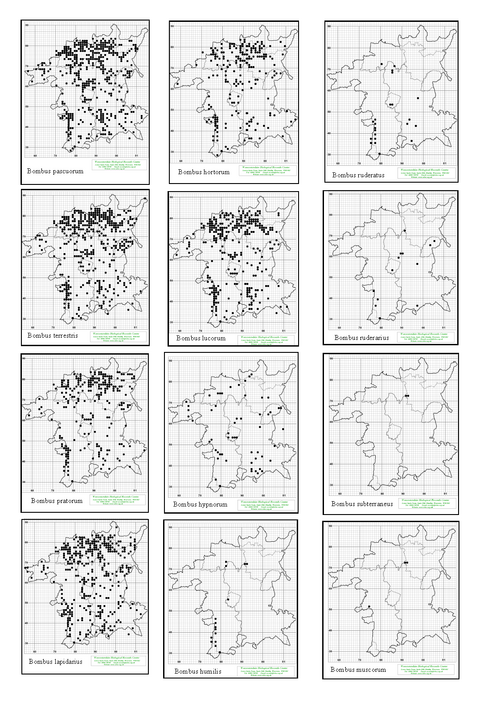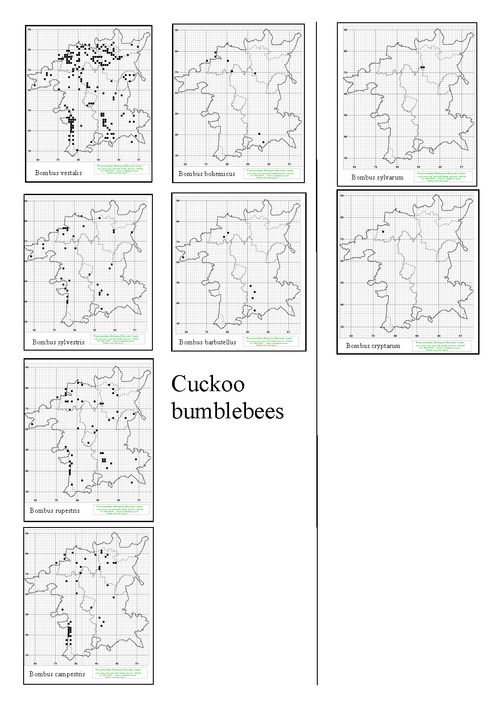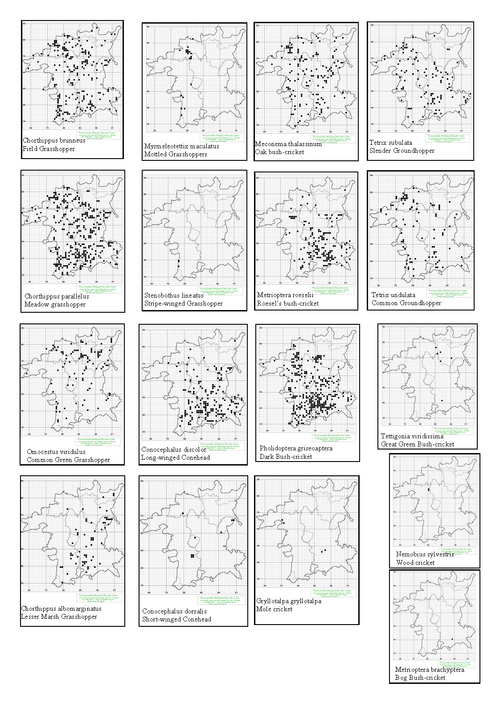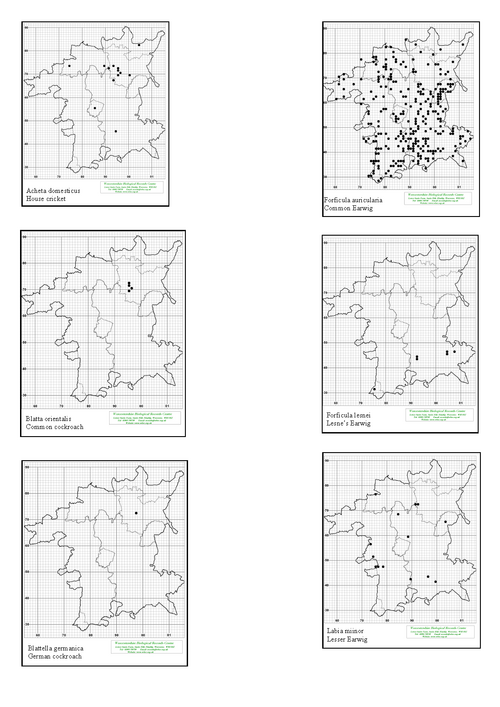Bumblebees and Orthoptera: Two new atlases
Harry Green
Worcestershire Recorders, working closely with Worcestershire Biological Records Centre (WBRC) aim to produce two illustrated county ‘Atlases’: ‘Bumblebees’ and ‘Orthoptera’ in the near future. To do this we need records so please help!
One of the main reasons for preparing these Atlases is because the national distributions of several species are changing either through new invasions or declines and these appear to be particularly noticeable in Worcestershire. Many bumblebee species are in severe decline apparently mainly due to intensive agriculture. However Britain and latterly Worcestershire has been invaded by Bombus hypnorum, the Tree Bumblebee, which has moved in from Europe. Amongst crickets two species of bush-crickets Conocephalus discolor , the Long-winged Conehead, and Metrioptera roeselii, Roesel’s Bush-cricket, have invaded the county within the last 12 years and they are still spreading westwards. Additionally very little has been published on these two groups in Worcestershire.
By February 2013 the WBRC database contained 3795 Orthoptera records and 4103 bumblebee records for Greater Worcestershire. These records are the base on which we can build further work, especially in 2013, by collecting as many new records as possible from all parts of Worcestershire. The aim is to produce illustrated accounts for all the species in these two groups that occur in the county. Each species account will probably contain a distribution map (hence ‘Atlas’), colour illustrations of the species, and a review of its natural history and status including any Worcestershire historical information that can be found.
A glance at the preliminary maps shows large holes in the distribution of many common species (Figs. 1-4 prepared by WBRC). Many of these holes are there simply because nobody has made records for those areas. Please try and visit such areas and make records. The success of these Atlases will depend on the enthusiasm recorders have for collecting new records in 2013.
Obtaining records of cockroaches (see Gary Farmer’s article) and for the two earwigs other than the common species presents a challenge. Farm manure heaps are supposed to be good for the Lesser Earwig and Lesne’s Earwig may be restricted to SE Worcestershire where it appears to inhabit Old-Man’s-Beard (Farmer 2012).
Some species in both groups are quite easy to identify, others are more difficult. Fortunately there are helpful modern guides to identification and good keys are included in recent volumes of Collins ‘New Naturalist’ series – see references.
Many people now use digital cameras to photograph insects and many of these Atlas species (but not all!) can with care be identified from pictures. For orthoptera Gary Farmer is offering an identification service – see his article on this Worcestershire Record. Most common species of bumblebees are fairly easy to identify but problems arise from differences between sexes and the worn bleached colours apparent as the bees get older, especially workers. The latter can also vary greatly in size. We can offer some help with photo identification of bumblebees although they are quite difficult to photograph showing identification features clearly. Pictures should in the first instance be sent to records@wbrc.org.uk. They will only be considered if they are accompanied by your name, date the bumblebee was seen, and location including grid reference (these can easily be determined from maps or the web site http://wtp2.appspot.com/wheresthepath.htm.
Receipt of pictures will be acknowledged hopefully with confirmation of identification. Records from these will be send to the WBRC database by us and you do not need to re-send them.
How to send in records.
Records should be sent to WBRC. They can be either as written documents posted to WBRC, Lower Smite Farm, Hindlip, Worcester, WR3 8SZ or by email to records@wbrc.org.uk. Please make sure your name and contact details are included. It is best to send records by email attachment if possible. The attachments can either be simple written documents but if you are sending a batch of records please, if possible, use the spreadsheet which can be down-loaded from the web site http://wbrc.org.uk/. On the front page click on An expanded Excel sheet for your records and on the next page click on An expanded Excel sheet can be found here and a spread sheet will automatically be downloaded to your computer. This can be saved and then used to send batches of records (you are advised to keep a copy of each batch).
References and guides to identification
Orthoptera
A useful guide is A photographic guide to Grasshoppers & Crickets of Britain & Ireland by Martin Evans & Roger Edmondson published in 2007 by WGUK. ISBN 978-0-9549506-1-3.
The older standard book which also contains cockroaches and earwigs is Grasshoppers and allied insects of Great Britain and Ireland by Judith A. Marshall & E. C. M. Haes published on 1988 by Harley Books. ISBN 0 946589 13 5.
There is a good key in Grasshoppers & Crickets by Ted Benton, volume 120 in Collins New Naturalist series published in 2012. The book also contains many good photographs and a wealth of useful information..
Farmer. G. 2012. Lesne’s Earwig Forficula lesnei. Scarce in Worcestershire or just overlooked? Worcestershire Record 33:24.
Bumblebees
The most useful guide is Field Guide to the Bumblebees of Great Britain & Ireland by Mike Edwards & Martin Jenner. First published by Ocelli in 2005, revised edition 2009. ISBN 9780954971311.
There is a good key in Bumblebees by Ted Bention, volume 98 in the Collins New Naturalist series published in 2006. The book also contains many good photographs and a wealth of useful information.
A great deal of useful information can be found on the Bees, Wasps and Ants Recording Society (BWARS) web site including a download Bees in Britain, see: http://www.bwars.com
The WBRC web site www.wbrc.org.uk contains all but the most recent contents of past Worcestershire Record and these include many notes and papers on bumblebees and orthoptera.
For both groups there are many images to be found through internet searches and these can be very helpful but take care as the identifications are not always correct.
Image
Fig. 1. Bumblebee distribution maps February 2013.WBRC
Fig. 2. Bumblebee distribution maps February 2013.WBRC
Fig. 3. Orthoptera distribution maps February 2013.WBRC
Fig. 4. Orthoptera distribution map earwigs & cockroaches February 2013.WBRC



